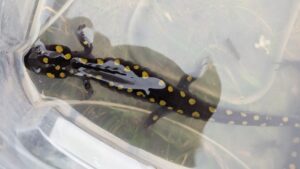If you enjoy exotic pets, you might like both salamanders and geckos. They are small, quiet animals that often live in similar-looking setups. They both like hiding under rocks or plants, and they seem to enjoy the same kind of space. You might wonder: could a salamander and a gecko live in the same tank?
No, salamanders and geckos should not live together. Their needs, behaviors, and risks are very different, making cohabitation unsafe for both.
Why It Seems Like a Good Match
At first, geckos and salamanders may look like a good pair. They are both small, ground-dwelling animals. They both eat insects. They both like hiding places and terrariums that look warm.
It’s easy to think they can live side by side. But their care needs are completely different. They come from different animal groups. If you put them together, both animals can suffer.
Temperature and Habitat Needs Are Too Different
Geckos Need Heat; Salamanders Need Cool, Moist Conditions
Geckos are reptiles. Most pet geckos need warm temperatures. Leopard geckos, for example, often need a warm side between 85°F and 90°F.
Even crested geckos, which like cooler heat, still need temperatures in the 70s.
Salamanders are amphibians. Most do best in cool, damp setups, usually between 55°F and 70°F. That’s a huge gap.

If you heat the tank for the gecko, the salamander may overheat or dry out. If you cool it for the salamander, the gecko may stop eating, get sick, or become too cold to move.
This mismatch alone makes it unsafe.
Lighting and Substrate Preferences Don’t Line Up
Geckos often need light during the day and sometimes mild UVB for bone health. Salamanders are the opposite. Most avoid light and do best in dim or dark spaces.
Bright light can stress them or cause skin problems.
The substrate they need is different too. Salamanders prefer damp soil, moss, or soft mulch to burrow. Geckos live on dry ground like paper towels, coconut fiber, or sometimes sand.
Trying to find a middle ground usually ends up working for neither animal.
Behavior and Feeding Conflicts
Geckos Are Active and May Bother Salamanders
Most geckos are more active than salamanders, especially at night. They move fast, climb walls, and explore the tank. Salamanders are slower and prefer quiet spaces.
A gecko darting around may scare, stress, or even injure a salamander without meaning to.
A gecko could sit on or crowd a salamander without noticing. For the salamander, that constant disturbance is dangerous. Stress like this can lead to illness, refusal to eat, or a shorter lifespan.
Biting Is a Risk
Geckos have sharp teeth and a fast bite. During feeding, a gecko might snap at something that moves. If that something is the salamander, it could get injured.
A leg, a tail, or even the body could be mistaken for prey. Small salamanders may even be eaten by a gecko.
Feeding Time Becomes a Competition
Both animals eat live prey like worms and crickets. Geckos are faster and more aggressive hunters. They may eat most of the food before the salamander reacts.
This leaves the salamander hungry and stressed. Over time, this causes malnourishment, poor health, or even starvation.
Disease and Cross-Contamination
Even if tanks look similar, geckos and salamanders are very different. Geckos are reptiles. Salamanders are amphibians. Their immune systems and skin work differently, so their risks of infection are not the same.

Sharing a tank means sharing air, surfaces, and food areas.
Bacteria, parasites, and fungi can spread between them. A mild reptile illness may be fatal to a salamander.
A waterborne fungus that doesn’t harm a gecko may cause deadly skin problems for a salamander.
Salamanders absorb everything through their skin. Leftover food, waste, or dirty water from a gecko could be dangerous.
Stress Adds Up Over Time
Even if both animals seem fine at first, problems may appear slowly. Stress is a silent killer in amphibians and reptiles.
If your salamander hides constantly, stops eating, or avoids moving, something is wrong. If your gecko becomes sluggish or eats less, that is also a warning. Mixed setups rarely work long term. One animal usually starts to decline.
Are There Any Safe Exceptions?
In professional displays, zoos may try mixed-species enclosures. These setups are extremely large, custom-built, and include physical barriers, separate hiding areas, and strict temperature controls.
They also involve daily health checks and backup tanks in case separation is needed. This level of care is not realistic for home terrariums.
For most keepers, housing a salamander and gecko together will cause serious problems or injury.
The Safer Choice: Two Tanks
If you enjoy both salamanders and geckos, the best choice is giving each their own space. This way, you can:
- Keep temperatures safe for each animal
- Choose the best lighting, substrate, and humidity
- Feed each one without competition
- Watch behavior and health without stress
- Prevent disease from spreading between them
You can still enjoy watching both animals side by side. You can even decorate tanks to match. The key is to keep them separate, for their safety and your peace of mind.
Conclusion
Salamanders and geckos should not share a tank. Their temperature, lighting, feeding, and behavior needs are too different. One animal will almost always suffer if they are kept together.
To keep both pets healthy and stress-free, give each one its own enclosure. It is safer, simpler, and far better for both animals in the long run.
Hi, my name is Ezra Mushala, i have been interested animals all my life. I am the main author and editor here at snakeinformer.com.

